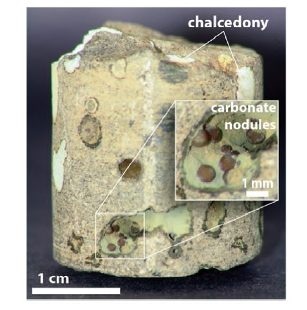Nov 21 2016
The Paris Climate Agreement will go into effect this November to minimize carbon emissions. According to experts, trapping and storing carbon should be part of the solution in order to realize the pre-determined targets.
 A core sample from a carbon storage project in Washington state showed that carbon dioxide injected deep underground into basalt rock turned into the carbonate mineral ankerite in less than two years. (Credit: American Chemical Society)
A core sample from a carbon storage project in Washington state showed that carbon dioxide injected deep underground into basalt rock turned into the carbonate mineral ankerite in less than two years. (Credit: American Chemical Society)
A number of projects worldwide are working to achieve that. Currently, a research on one of those endeavors has discovered that in a matter of two years, carbon dioxide (CO2) injected into basalt changed into solid rock. Their findings have been reported in the ACS journal Environmental Science & Technology Letters.
Laboratory studies on basalt have revealed that the rock, which formed from lava numerous years ago and is found all across the world, can quickly convert CO2 into stable carbonate minerals. This evidence indicates that if CO2 could be trapped into this solid form, it would be stored away permanently, without ever escaping into the atmosphere. However, whatever is achieved in the lab does not necessarily reflect what happens in the real world. One field project based in Iceland injected CO2 pre-dissolved in water into a basalt formation, where it was effectively stored. And since 2009, researchers with Pacific Northwest National Laboratory and the Montana-based Big Sky Carbon Sequestration Partnership carried out a pilot project in eastern Washington to inject 1,000 tons of pressurized liquid CO2 into a basalt formation.
In 2013, after drilling a well in the Columbia River Basalt formation and analyzing its properties, the research team injected CO2 into it. Core samples were taken from the well after two years. Pete McGrail and colleagues established that the CO2 had certainly converted into the carbonate mineral ankerite, just as the laboratory experiments had predicted. And as basalts are extensively found in North America and across the world, the researchers propose that the formations could help permanently trap and store carbon on a large scale.
The authors received funding from the U.S. Department of Energy; the National Energy Technology Laboratory; the Big Sky Carbon Sequestration Partnership; Shell Exploration & Production Company; Portland General Electric; and Schlumberger Inc.